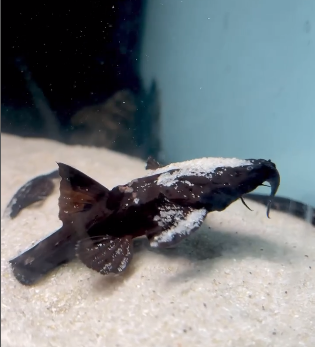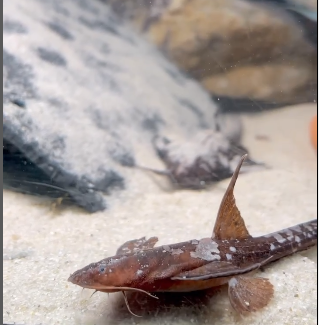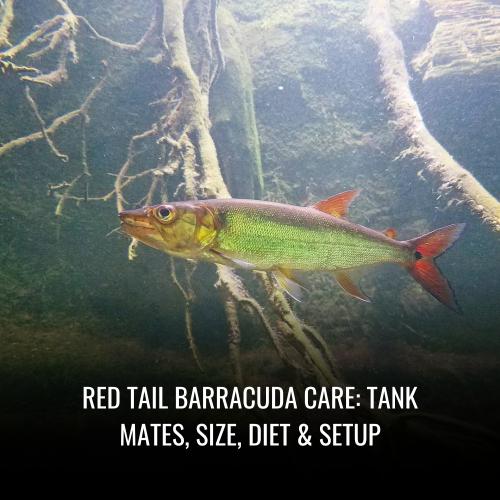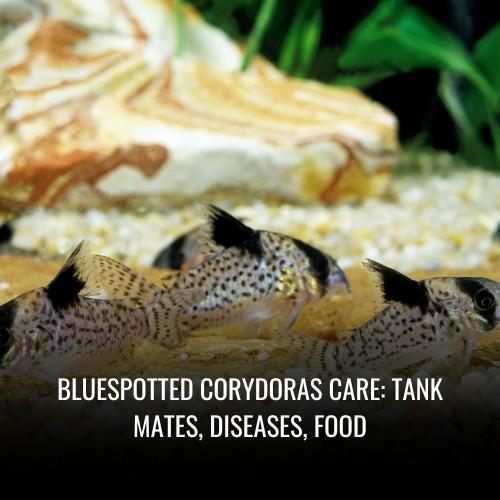Banded banjo Care: Tank Size, Lifespan, Food & More
This post contains affiliate links. As an Amazon Associate, we earn from qualifying purchases.
If you’re a fan of unique and intriguing aquarium fish, then the banded banjo is definitely one to consider. With their distinctive appearance and peaceful nature, banded banjos are a captivating addition to any tank. From their behavior and diet to their ideal tank mates and breeding habits, there’s so much to learn about these fascinating creatures.
| Feature | Description |
|---|---|
| Scientific name | Chaca chaca |
| Common name | Banded banjo |
| Family | Chacidae |
| Usual size in fish tanks | 8 inches (20 cm) |
| Recommended pH range | 6.0 – 7.0 |
| Recommended water hardness (dGH) | 5 – 12 dGH |
| Recommended temperature | 75-82°F (24-28°C) |
| Reproduction process | Breeds through scattering adhesive eggs |
| Origin | South America, primarily in the Amazon |
| Temperament to its own species | Peaceful, can be solitary |
| Temperament toward other fish species | Generally peaceful, may eat smaller fish |
| Usual place in the tank | Bottom-dwelling |
| Lifespan | 8-10 years |
| Tank size requirement | 30 gallons (113 liters) or larger |
| Filtration system | Strong filtration preferred |
| Sexual dimorphism | Females are larger and broader than males |
| Substrate cleaning | Can help clean the tank floor with its movements |
The banded banjo, also known by its scientific name, is a charming and quirky fish that can bring a lot of character to your aquarium. They are known for their peaceful temperament and interesting behavior, making them a popular choice for fish enthusiasts looking to diversify their tank. In this article, we’ll explore the various aspects of banded banjo care and maintenance, from their natural habitat to their ideal tank setup.
Join us as we delve into the world of banded banjos, learning about their behavior, diet, tank requirements, and much more. Whether you’re a seasoned aquarist or a beginner looking for unique fish to add to your aquarium, this comprehensive guide will provide you with all the information you need to care for these captivating creatures.
Scientific Name
The Banded Banjo, known scientifically as Cotylephorus blochii and alternatively as Silurus hexadactylus, belongs to a group of fishes that have seen several taxonomic reclassifications over time, reflecting the ongoing evolution within ichthyological studies. Initially classified as Platystacus cotylephorus, this species has undergone thorough taxonomic review, denoting our increasing understanding of its distinct lineage.
This catfish has also been called the Whiptailed Banjo Catfish due to its notable eel-like tail, adding to the unique identifiers by which this species can be recognized. The numerous names it has gone by are a testament to both its distinctive morphology and the historical taxonomy of these aquatic creatures.
Below is a list that encapsulates its taxonomic journey:
- Initially classified as: Platystacus cotylephorus
- Also referred to as: Silurus hexadactylus
- Currently known as: Cotylephorus blochii
- Commonly nicknamed: Whiptailed Banjo Catfish
These names constitute the layered nomenclature that underpins the Banded Banjo’s scientific identity.
Average Size
The Banded Banjo Catfish is a species that catches the eye with its unique appearance, especially when it reaches its full size. On average, these slender fish stretch to a length of 6-8 inches as adults, presenting a distinctive profile in both natural habitats and aquariums. Their elongated bodies culminate in a striking eel-like tail, contributing to their streamlined shape that is well-suited for efficient movement through water.
Interestingly, size can vary between the sexes. Aged females often grow larger, sometimes exceeding the norm to reach sizes up to 10 inches, while males remain within the average range. This size variance is not just seen between males and females, but also as the fish progress from juveniles to adults. Young Banded Banjo Catfish are only a few inches long and experience a significant growth spurt as they mature.
| Age Stage | Average Length |
|---|---|
| Juvenile | 2-4 inches |
| Adult | 6-8 inches |
| Aged Female | Up to 10 inches |
These dimensions highlight the Banded Banjo Catfish’s growth from a diminutive juvenile to a more formidable adult, with females possibly laying claim to a larger size in their senior years.
Lifespan
The Banded Banjo Catfish, scientifically known as Platystacus cotylephorus, boasts a respectable lifespan in the confines of a captive environment. With attentive care, these unique fish can live for 8-12 years, making them a long-term commitment for any aquarist. Achieving this full potential lifespan hinges on several key elements of care.
To ensure these catfish thrive, maintaining good water quality is imperative. A well-maintained aquarium mimics their natural habitat and lessens stress, contributing to their longevity. Regular tank maintenance, such as timely water changes and filter upkeep, plays a significant role.
Diet is another factor that can’t be overlooked. A balanced diet, often comprised of frozen foods akin to their brackish water diet, supports their health. Stressors that may cut their lives short, like poor water conditions, overcrowding, or poor nutrition, must be diligently avoided.
| Care Aspect | Impact on Lifespan |
|---|---|
| Water Quality | Major |
| Tank Maintenance | High |
| Stress-free Environment | Crucial |
| Balanced Diet | Essential |
By adhering to these guidelines, the captive Banded Banjo Catfish can indeed achieve a full, vibrant life of up to 12 years.
Natural Habitat
The Banded Banjo Catfish, P. cotylephorus, finds its origins in the meandering coastal rivers of South America, an area known for its brackish and coastal waters. These waters, often turbid and full of suspended silt, provide the perfect backdrop for this species. The dimly lit, muddy substrates of these regions readily mimic the catfish’s native habitat, a network of murky river bottoms rich in organic matter.
A noteworthy mention is the Mottled Eel-Tailed Banjo Catfish, which shares these habitats. Particularly, it is the aged females that show a strong preference for the tranquility of shadowy spaces, adding to the reclusive nature of the environment. During daylight, P. cotylephorus is more active, exhibiting an unusual method of seeking food after the lights have been on, an adaptation perhaps tied to their natural rhythms and feeding times.
These American catfishes are in their element within these muddy environs, gracefully navigating the water column, and this predilection makes them fascinating both to observe in the wild and to nurture in aquarium settings.
| Habitat Feature | Importance to P. cotylephorus |
|---|---|
| Brackish Water | High |
| Coastal Rivers | Essential |
| Muddy Substrates | Crucial |
| Dim Lighting | Preferred |
| Turbid Waters | Natural |
Appearance
The appearance of the Banded Banjo Catfish, scientifically known as P. cotylephorus, is striking and distinctive, characterized by an elongated, eel-like body that can achieve lengths of approximately 6 inches in adult individuals. Their coloration gracefully blends from lighter shades of brown to deeper hues, accented with bands and mottled patterns reminiscent of a banjo—the inspiration behind their common name.
The Banded Banjo Catfish further distinguishes itself with a unique eel-tail, setting it apart from other catfishes. Intricate patterns and markings embellish their pectoral and dorsal fins, adding to the elegance of this species. The smooth, slimy texture of their skin is not just for show; it is a critical adaptation for life in their low-visibility, muddy habitats.
Equipped with sensitive barbels around the mouth, these catfish exhibit remarkable finesse in navigating their dimly lit environments. The barbels act as sensory organs, aiding in the search for food amidst the shadows. Below is a concise breakdown of their key appearance traits:
| Key Feature | Description |
|---|---|
| Body Shape | Elongated, eel-like |
| Size | Medium (up to 6 inches in adults) |
| Color | Light to dark brown, mottled bands |
| Tail | Eel-like tail |
| Fins | Patterned pectoral and dorsal fins |
| Skin | Smooth and slimy |
| Barbels | Sensory organs around the mouth |
This ensemble of features makes the Banded Banjo Catfish not only a master of its murky realm but also a captivating specimen for enthusiasts and aquarists alike.
Behavior & Temperament
The Banded Banjo Catfish, a native of the turbid and coastal waters of South America, brings a unique blend of tranquility and mystery to the home aquarium. With its reclusive and peaceful demeanor, this catfish prefers the dimness of shaded environments, adapting exceptionally well to the subdued lighting of captivity. These catfish spend their daylight hours nestled within the comfort of the tank’s hideaways, showcasing an inactive lifestyle that makes them perfect for communal living with non-aggressive species.

Are Banded Banjo Fin Nippers?
When considering compatibility in a community tank, a common concern is whether a new addition might exhibit fin-nipping – a behavior that can cause stress and harm to other fish. Banded Banjo Catfish, however, are not known to engage in such behavior. These bottom dwellers prefer to mind their business, foraging through soft, sandy substrates rather than bothering their tank mates’ fins. Their diet mainly consists of insects and small crustaceans, which keeps their focus away from nipping at other species.
Are Banded Banjo Aggressive To Each Other & Other Fish?
Aggression is seldom a concern when it comes to the Banded Banjo Catfish. Mild-mannered and non-confrontational, these catfish are as peaceful towards their own kind as they are towards other fish. Their docile nature makes them excellent candidates for community tanks, where they often fade into the backdrop, avoiding any disputes over territory or food. Their presence is calm and unassuming, providing a stress-free environment for fellow aquatic inhabitants.
Are Banded Banjo Friendly To Each Other & Other Fish?
While ‘friendly’ may not be the precise term for the Banded Banjo’s somewhat reclusive nature, they are undoubtedly harmonious tank mates. They coexist without issue in a shared space, quietly going about their routines. The Banded Banjo Catfish’s passive nature renders them non-threatening to neighbors, sustaining a pleasant ambiance within the communal underwater setting.
Are Banded Banjo Schooling Fish?
Unlike some of their kin, Banded Banjo Catfish do not display schooling behavior. They lead a solitary existence that aligns with their preference for personal hideouts amidst the tank’s muddy substrate. In the aquarium, it is not uncommon to find these catfish independently meandering or resting, showing little inclination towards forming groups or shoals.
Can You Have Just One Banded Banjo In The Tank?
Given their solitary habits, a single Banded Banjo Catfish can live quite contentedly in an aquarium. They do not require the company of their species to thrive and can establish their domain without the presence of conspecifics. Aquarists can be confident that housing a singular Banded Banjo will not result in loneliness-induced stress, as these catfish naturally enjoy their own company and the peace that comes with it.
Do Banded Banjo Need To Be In Groups?
Although the Banded Banjo Catfish can lead a fulfilled life on its own, grouping these catfish can create a more dynamic display and encourage natural behavior. Keeping a few individuals together—in a minimum group of three or four—can provide them with the semblance of social interaction, seen in their wild habitat where they occasionally gather in loose aggregations. Observing the subtle social structure and interaction that unfolds in a group can be a joy for the aquarist and beneficial for the catfish, providing them with a sense of security and well-being in the simulated ecosystem of the aquarium.
In conclusion, the Banded Banjo Catfish’s behavior and temperament set the stage for a serene and captivating addition to the freshwater aquarium. Their non-aggressive and peaceful nature, combined with their adaptability to communal living, makes them a sought-after choice for both novice and experienced aquarists.
| Temperament Trait | Description |
|---|---|
| Fin Nipping | Not prone to fin-nipping |
| Aggression | Non-aggressive towards others |
| Sociability | Peaceful, though not particularly social |
| Schooling | Lacks schooling behavior |
| Tank Requirement | Can be kept alone or in groups |
| Group Behavior | May exhibit more natural behaviors in small groups |
Food & Diet
The diet of Banded Banjo Catfish reflects their adaptive nature and carnivorous leanings. As scavengers, they show a willingness to consume a diverse range of foods, with a noticeable preference for live or frozen foods that mimic their natural diet in the wild of South America. Their feeding habits can be quite flexible in an aquarium setting, consolidating their reputation as a manageable species for aquarists.

Do Banded Banjo Eat Algae?
Though Banded Banjo Catfish are equipped to scavenge, they are not known to seek out algae as a primary food source. These carnivorous catfish are naturally inclined to feed on insects and mobile benthic crustaceans. Their typical menu does not feature algae, and while incidental ingestion may occur during their foraging, they do not contribute significantly to algae control in the tank environment. A protein-based diet, similar to what they would encounter in the muddy substrates of coastal rivers, ensures their health and vitality.
Do Banded Banjo Eat Shrimp?
Shrimp forms a favored component of the Banded Banjo Catfish diet. In their native brackish and freshwater habitats, these catfish relish various invertebrates, with shrimp being a considerable part of their intake. Offering them live, frozen, or freeze-dried shrimp in captivity not only satisfies their nutritional requirements but also stimulates their instinctual foraging behaviors, especially under dim lighting conditions they prefer.
Do Banded Banjo Eat Bloodworms?
Bloodworms are indeed an attractive food choice for Banded Banjo Catfish. As bloodworms are a type of small aquatic invertebrate, they fit seamlessly into the catfish’s natural, carnivorous diet. The provision of bloodworms, whether live or frozen, is essential for mimicking the diverse and protein-rich diet they would have access to in their turbid, natural environments. These foods provide necessary nutrients, contributing greatly to the catfish’s well-being in a tank setting.
Do Banded Banjo Eat Mosquito Larvae?
Banded Banjo Catfish see mosquito larvae as an opportunistic treat. Preying on these larvae aligns with their predator instincts and can be particularly beneficial in controlled aquatic settings by naturally limiting mosquito populations. Including mosquito larvae in their diet reinforces the catfish’s predatory nature and provides a rich source of protein that aids in maintaining their health in the contained, often less turbid waters of an aquarium.
Do Banded Banjo Eat Planaria?
Although Banded Banjo Catfish are not selective eaters, planaria can constitute part of their varied diet due to their carnivorous preferences. These small invertebrates are among the range of food sources Banded Banjo Catfish might encounter in their muddy, natural habitat and consume during their period of active foraging. In captivity, offering planaria can add diversity to their diet, closely simulating their wild feeding experience.
Do Banded Banjo Eat Plants?
While Banded Banjo Catfish may incidentally ingest plant material during their bottom-dwelling search for food, plants are not a staple in their diet. These catfish prioritize meaty treats in their feeding routine over vegetation. This dietary predisposition means that plant matter is not actively sought by the Banded Banjo Catfish, and aquarists should focus on supplementing their diet with appropriate, protein-enriched foods that meet their carnivorous needs.
| Banded Banjo Dietary Preferences | Description |
|---|---|
| Live and Frozen Foods | Essential for meeting nutritional requirements and simulating natural feeding behaviors |
| Algae | Not a preferred or significant part of their diet |
| Shrimp | Highly favored and nutritionally beneficial |
| Bloodworms | An attractive and nutrient-rich food option |
| Mosquito Larvae | Opportunistic food source and beneficial for pest control |
| Planaria | Accepted as part of their carnivorous diet |
| Plant Matter | Incidental ingestion but not a dietary focus |
As scavengers and opportunistic feeders, Banded Banjo Catfish display a preference for a varied, carnivorous diet, primarily consuming insects, invertebrates like shrimp and bloodworms, and small crustaceans. They thrive in aquarium settings when provided with a diet that emulates their natural intake, highlighting the importance of offering a mixture of live and frozen foods. While algae and plants may be encountered in their environment, they do not form a mainstay of their dietary habits.
Sexing: Male vs Female
Sexing Banded Banjo Catfish can be relatively straightforward if you know what to look for. One of the most distinguishing features is the dorsal fin, with males generally having a longer fin compared to the shorter dorsal fin found on females. When observing color, females typically exhibit a mostly brown hue with minimal mottling, whereas males boast a darker shade interspersed with distinctive mottling patterns.
Mature males also present with larger pectoral fins in comparison to their female counterparts, which can be an additional visual cue used for sexing. These differences become more evident as the Banded Banjo Catfish mature, making the sexing process easier within a tank environment.
Key Identifiers for Sexing Banded Banjo Catfish
| Gender | Dorsal Fin | Coloration | Pectoral Fin Size |
|---|---|---|---|
| Male | Longer | Darker with mottling | Larger |
| Female | Shorter | Mostly brown, less mottle | Comparatively smaller |
To accurately identify the gender of Banded Banjo Catfish, observe these features closely, as they offer clear indicators to differentiate between males and females.
Banded banjo Tank Mates
Banded banjo catfish are quintessential companions for serene aquarium communities. Often found lounging on the bottom, they cohabit splendidly with other peaceful bottom-dwellers like Corydoras catfish and unassuming loaches. Their reclusive tendencies make them excellent mates for non-aggressive mid-level swimmers too, such as tetras and rasboras who flit above without disruption.
To ensure a harmonious habitat, it is wise to pair them with fish that differ in dietary preferences. Small cichlids, notably Apistogramma, and placid gouramis are exemplary for this role, as they tend to forage in different tank zones. However, tank owners should sidestep the temptation to add larger, boisterous fish that might intimidate these shy creatures or compete aggressively for meals.
For those seeking a diversified ecosystem, the addition of shrimp and small, gentle invertebrates like snails can enhance the tranquility of the aquatic environment. Such tank mates not only coexist well with the banded banjo but also contribute to a balanced aquatic community.
Ideal Tank Companions for Banded Banjo Catfish:
| Bottom Dwellers | Mid-Level Swimmers | Invertebrates |
|---|---|---|
| Corydoras | Tetras | Shrimp |
| Small Loaches | Rasboras | Snails |
| Apistogramma | Peaceful Gouramis |
By carefully choosing tank mates that respect the banded banjo’s need for peace and subdued lighting, aquarists can craft a harmonious underwater sanctuary.
Aquarium Setup
Creating the perfect aquarium environment for your Banded Banjo Catfish is akin to crafting a miniature version of their natural habitat. To start, the dimensions of the tank are paramount. A single Banded Banjo requires a 30-gallon aquarium at the minimum. However, if you’re looking to house a small group, aim for a 55-gallon tank or larger to ensure each has enough territory and comfort.
Your setup should include plenty of hiding spots, given their reclusive nature. Use natural décor like plants, driftwood, and rocks to replicate the muddy, turbid environments of coastal rivers and brackish waters where these catfish originate. A soft, sandy substrate not only allows them to exhibit their burrowing behavior but also prevents damage to their delicate barbels.
Ideal Tank Size
| Number of Banded Banjo Catfish | Minimum Tank Size | Recommended Tank Size |
|---|---|---|
| 1 | 30 gallons | 55 gallons |
| Each additional fish | +10 gallons | – |
Given their elongated bodies and eel-like movement, an ideal tank would have at least a length of 36 inches. While Banded Banjo Catfish are likely to remain stationary, the sizeable length affords them the comfort to explore and shift positions without stress.
Ideal Water Parameters
To ensure your Banded Banjos flourish, maintain water temperatures between 22 to 25 degrees Celsius, with a pH range of 6.0 to 8.0, leaning towards neutral to slightly alkaline. For the general hardness (GH), keep it within 12 to 30 GH. If your catfish are the lone inhabitants, a freshwater setup is adequate; however, if housing with brackish water species, replicate those conditions accordingly. Keep in mind very clean water is critical; perform regular water quality checks and maintenance to sustain their health.
Filtration
The invisible yet crucial component to your Banjo catfish’s well-being is an efficient filtration system. Use a canister or sump filter robust enough to cycle the tank’s water volume multiple times an hour. The filter should feature a combination of mechanical, biological, and chemical filtration to handle the waste and contaminants inherent to turbid water lovers like your Banjo catfish. Regular cleaning of the filter media is also essential to prevent the accumulation of harmful substances.
Lighting
Mimic the dim lighting of their natural environments to make your Banded Banjo Catfish truly at home. Opt for indirect lighting with floating plants or adjustable LED lights to recreate the dappled light of muddy, vegetated waterways. Maintain a consistent day-night cycle, with subdued lighting during daylight hours and slightly brighter illumination in the evening. Steer clear of bright, direct light; it increases stress for the catfish and promotes unwanted algae growth.
Common Possible Diseases & Prevention
Like any other aquarium residents, Banded Banjo Catfish are prone to certain health issues, including ich (white spot disease), and infections both fungal and bacterial. These ailments largely stem from subpar water conditions and undue stress.
Prevention Tips:
- Regular tank cleaning and effective filtration are paramount.
- Oxygen levels should be optimal through proper aeration.
- Introduce new fish via quarantine to safeguard against disease spread.
- Vigilance with water testing is crucial to ensure ammonia and nitrite are nonexistent.
Be cautious with medications, especially copper-based, as Banded Banjo Catfish are copper-sensitive and may suffer toxicity. An ounce of prevention is worth a pound of cure, and meticulous care ensures your fish thrive.
Ideal Water Conditions:
| Parameter | Ideal Level |
|---|---|
| Ammonia | 0 ppm |
| Nitrite | 0 ppm |
| Oxygen | High saturation |
Short, actionable steps and consistent monitoring ward off common diseases and foster a thriving aquatic environment for your Banded Banjo Catfish.
Breeding Banded banjo In Aquarium
To breed Banded Banjo Catfish in an aquarium, creating an environment akin to their natural South American habitats is essential. Condition the breeding tank with dim lighting and sandy substrates for a comfortable, natural setting. Include abundant hiding places like driftwood and rock formations where fish can lay eggs and ensure the security of their young.
Crucial to breeding success is the meticulous maintenance of water parameters. Match the conditions they typically experience in the wild:
| Water Parameter | Recommended Range |
|---|---|
| pH | 6.7 – 8.2 |
| Hardness | 12 – 24°N |
| Temperature | 22 – 25 °C |
Pairs display courtship behaviors with males guarding nests and females depositing eggs onto the substrate to be fertilized. Male vigilance in nest protection is part of the ritual.
A spacious aquarium setup is suggested to allow for these behaviors and to prevent crowding as offspring grow. Diet plays a role too; provide a mix of live, frozen, and pellet foods suitable for carnivores to ensure nutritional needs are met and fish are in peak breeding condition.
Nutrition for Breeding:
- Bloodworms
- Mosquito larvae
- Carnivorous pellets
This balanced approach facilitates the reproduction of Banded Banjo Catfish in a home aquarium.
Are Banded banjo Easy To Keep?
Banded Banjo Catfish, with their easygoing nature and adaptability, are well-suited for both novice and seasoned aquarium enthusiasts. In a domestic aquarium, these fish display resilience and a capacity for enduring various water conditions. They thrive in enclosures that mimic their natural inclination for dimly lit and muddy environments, which translates into an undemanding approach to tank setup. The leniency in decoration and lighting choices offers aquarists substantial flexibility.
Notably, Banded Banjo Catfish are hardy creatures, tolerant of typical fluctuations in tank parameters such as minor shifts in water temperature and pH levels. This characteristic makes them an appealing low-maintenance option for a community tank. They are accommodating to a range of water conditions and aren’t overly sensitive to routine water changes or slight differences in water quality. Hence, their presence is reassuring for those who may not maintain an exacting schedule of tank maintenance.
Furthermore, their peaceful demeanor underlines their ease of care, as they coexist without issue alongside various fish species. The likelihood of conflict is minimal, ensuring a serene tank environment. Here’s a snapshot of why Banded Banjo Catfish are straightforward to care for:
- Temperament: Peaceful and adaptable to diverse water conditions.
- Tank Setup: Flexible with tank decorations and lighting, preferring muddy substrates and dim lighting.
- Maintenance: Resilient to common tank parameter changes, requiring less stringent water quality control.
- Compatibility: Non-aggressive nature ensures easy cohabitation with other fish.

Are Banded banjo Sensitive To Water Changes?
While Banded Banjo Catfish are adaptable and easygoing by nature, they, like any other fish, have their limits. They exhibit sensitivities to rapid changes in their aquatic environment, necessitating a slow and careful acclimation process. Abrupt variations in temperature, pH, or hardness can lead to stress, which can, in turn, compromise their immunity and overall health.
To ensure the welfare of Banded Banjo Catfish, it is important to monitor water quality closely. They are particularly vulnerable to abrupt increases in ammonia and nitrites, making a well-cycled aquarium with dependable biological filtration an essential aspect of their care. Here are key recommendations for water change management:
- Acclimation: Introduce Banded Banjo Catfish to new water conditions gradually to minimize stress.
- Water Quality Monitoring: Keep a watchful eye on water parameters to detect any harmful fluctuations.
- Water Stability: Strive to maintain consistent water conditions to promote the well-being of the catfish.
- Filtration: Ensure that the tank is equipped with efficient filtration to manage waste and ammonia levels.
Are Banded banjo Sensitive To Ammonia?
In their natural habitats, Banded Banjo Catfish inhabit brackish and freshwater areas where water purity is vital. Therefore, these catfish can be moderately sensitive to heightened levels of ammonia. An excess of ammonia, a byproduct of their carnivorous diet, can lead to unfavorable health effects and a reduced immune response, heightening their susceptibility to illness.
Maintaining an ecological balance in the tank is fundamental to avoid ammonia spikes. It is particularly important to have efficient filtration systems in place to handle the waste these fish produce. Through keen vigilance and regular tank upkeep, ammonia levels can be kept within safe limits to support the health and longevity of Banded Banjo Catfish.
- Cycling: Adequately cycle the tank before introducing Banded Banjo Catfish.
- Monitoring: Check ammonia levels frequently to ensure they remain low.
- Water Changes: Perform consistent water changes to manage waste and prevent ammonia buildup.
- Filtration: Invest in proper filtration to process and diminish harmful substances in the tank.
Are Banded Banjo Sensitive To Copper?
Belonging to the Aspredinidae family and commonly found in the brackish and freshwater environments of South American coastal rivers, Banded Banjo Catfish (Platystacus cotylephorus) are particularly sensitive to copper. With a recommended water hardness between 12 – 24°N (214.29 – 428.57ppm), it becomes clear that their habitat requirements include a low tolerance for copper, which must be carefully monitored to prevent toxicity.
Copper can infiltrate aquariums through various sources, like pipes and water treatments, necessitating a copper-free tank environment for these peaceful fish. Excessive copper can have detrimental effects on their health and well-being. As such, it is imperative for aquarists to take a responsible approach in researching and implementing practices that keep the tank copper-free. Here’s a guide to managing copper levels:
- Test Water: Use a reliable test kit to measure copper concentration in the aquarium water.
- Source Water: Ensure the source water is free of copper contamination, possibly by using water conditioners or filtering the tap water before use.
- Aquarium Materials: Choose tank equipment, decorations, and treatments that do not leach copper.
- Water Treatment: Opt for copper-free treatments and medications to safeguard the health of the fish.
By following these protective measures, aquarists can maintain a safe and copper-free habitat for their Banded Banjo Catfish, ensuring their thriving existence in the home aquarium.






